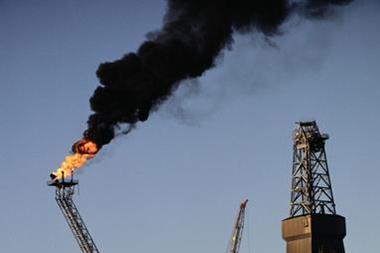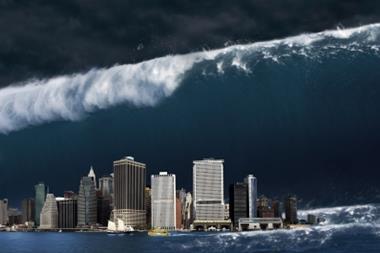The attack on the World Trade Center and the Madrid and London bombings are just some of the recent attacks that keep the terrorist threat at the forefront of our minds. But as well as these traditional terrorist acts, which focus on immediate death and destruction, there is a growing risk that attacks will become more diverse and sophisticated, with the possible use of chemical, biological or radiological/nuclear (CBRN) weapons.
Incidents in the US highlight the scale of damage such an attack could cause. A recent example was the contamination of a property with anthrax. The building apparently cost some $150m, to clean but some employees were reluctant to return there. Employers would face an even worse problem with radiological attacks.
The much-hyped 'dirty bomb' may not be the greatest risk to life when its immediate effect is compared with conventional explosives, but it could render large areas of property uninhabitable for a considerable period of time. And removing radioactive material is a very different proposition to clearing toxic smoke contamination following a fire or explosion.
CBRN materials can be deployed in a number of ways, including:
- chemical - liquid/aerosol or gaseous dispersion
- biological - spray, wet or dry
- radiological - dirty bomb or spray
- nuclear - detonation of nuclear device.
Substances could be deployed from the air, ground or via air handling systems (HVAC), with the effect within buildings dependent on the design and operation of the HVAC system. These methods of deployment are influenced by weather conditions, making control of deployment even more difficult to monitor.
Once the materials have been released, there are a number of ways in which they can enter the human body. Substances could be absorbed through skin or inhaled as a vapour, aerosol or dust. Injection via abrasions or wounds is also a risk, as is ingestion via contaminated food or drink or unclean hands.
Chemical weapons
Chemical weapons come mainly in gas or liquid forms, possibly deployed via an aerosol spray. Any highly volatile compound quickly disperses in open air, which may result in only minimal dosages to the intended victims. Less volatile materials can linger for a longer period.
CBRN materials are generally more lethal when used in closed spaces. Such weaponry has been used in war-stricken areas such as Iraq and during World War I, and decontamination skills have developed in dealing with toxic spillages from accidents involving chemicals.
Biological weapons
Biological weapons are formed from bacteria, viruses, toxins or fungi to produce death or disease in humans, animals, or plants. Effective deployment is likely to be more difficult than the effective deployment of chemical weapons. Person to person transmission can also occur. Such materials are relatively inexpensive to obtain, and many can be grown in fermenters like those used by pharmaceutical companies. The effects can be difficult to diagnose and treat and an attack could overwhelm the medical services.
Some successful decontamination procedures have so far been developed for anthrax, and such procedures may also be effective on other biological agents. However, much more research and testing is necessary for adequate preparation.
Dirty bomb
In essence, a dirty bomb is a quantity of radioactive material that is dispersed into a wide area using a conventional explosive. The radioactive material it contains plays no part in detonating the bomb.
Dirty bombs can be made using many different radio-isotopes - substances that naturally produce alpha, beta or gamma radiation. The amount of radioactivity emitted by these substances varies significantly, but large areas of property could be made uninhabitable for a considerable time.
The International Atomic Energy Agency (IAEA) attempts to keep track of radioactive materials. However, security standards reflect the degree of hazard presented by each material and radioactive materials are used extensively in medicine, industry, agriculture and research. Many are easier to acquire than the materials that would be required to produce a nuclear explosion.
The amount of explosive need not be large and the effects may not kill anyone. Anyone nearby would know a bomb had exploded, but would not automatically know it was a dirty bomb: you cannot taste, smell, feel or see radiation. Highly specialised techniques are required for removal of radioactive material.
Emergency response and decontamination
In the UK, the Home Office holds primary responsibility for counter-terrorism. In July 2001 it set up the Civil Contingencies Secretariat to improve the resilience of central Government and the UK. Resilience is defined as the ability to handle any disruptive challenges, including terrorism. Under the Government's 'New Dimension' programme, some 80 new incident response units (IRUs), have been provided to decontaminate large numbers of the public at the site of a CBRN incident. Emergency exercises are being planned and undertaken. Several government guidance documents on decontamination following exposure to CBRN material have also been produced.
At present, there are relatively few companies in the UK that could handle radiological decontamination. Experience is mainly based on nuclear decommissioning and specific, relatively minor, incidents. Any longer-term clean-up operation would probably be beyond the capabilities of the existing damage mitigation companies.
On 3 October, DEFRA announced that the new government decontamination service (GDS) was formally open for business. The service is intended to:
- provide guidance to responsible authorities on contingency planning
- determine competence of contractors for cleaning up CBRN materials (either accidental or terrorist related)
- provide guidance to government on the national capability to deal with CBRN decontamination
- help coordinate decontamination operations if required.
In the event of a terrorist attack involving CBRN material, access to any affected site would be restricted, until clean up measures had been implemented. This would mean that site visits by adjusters would be severely delayed.
It may be more appropriate for initial damage appraisals to be carried out by specialists familiar with the type of substance concerned and wearing CBRN personal protective equipment (PPE), perhaps using a combination of digital video recording and photography. However, so far no UK decontamination companies have been tested in a response to a real CBRN terrorist incident.
- Roger Stokes is a chemical engineer, Crawford & Company. Tel: 7802 591223, E-mail: roger.stokes@crawco.co.uk



















